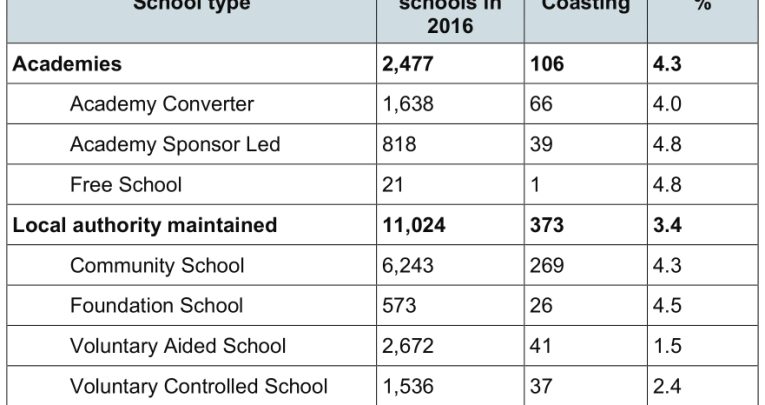New DfE Figures Identify First Batch Of Coasting Schools

804 schools currently found to be coasting, based on 2014/15 results

- by Teachwire

The Department for Education has released a set of figures which show that 804 schools in England (479 primaries and 327 secondaries, including two schools with KS2-KS4 intakes) fall under the government’s proposed definition of ‘coasting schools’ – a new performance measure set out within the Education and Adoption Act 2016.
The findings are based on the final results for 2014 and 2015 and provisional results for 2016. However, no schools will be formally idenified as coasting until the publication of the revised 2016 results over the next couple of months – due in December for KS2 and January 2017 for KS4.
If and when a school falls within the definition of coasting, a regional school commissioner will assess whether the school’s leadership team requires additional support. RSCs will be able direct coasting maintained schools to convert to sponsored academies, or for coasting academies to move to a new trust, but the DfE presently expects that this will only happen ‘In a small minority of cases’.
At primary level, 4.3% of academies were identified as coasting, against 3.4% of LA maintained schools. Within that, the largest proportion of coasting schools was among sponsor-led academies (4.8%) and LA maintained foundation schools (4.5%).
At secondary, 9% of academies were defined as coasting, versus 13.9% of academies. Again, the highest proportions were to be found among sponsor-led academies (19.5%) and LA-maintained Foundation schools (22.4%).
Schools exlcuded from being defined as coasting include pupil referral units, special schools and special academies and maintained nursery schools. The definition will further not apply to primaries with fewer than 11 pupils or secondaries with fewer than six (or 11 in 2014 or 2015), or to schools in which fewer than 50% of pupils have taken tests or assessments that produced valid progress data.
The definition explained
As things currently stand (the government’s current definition still requires formal Parliamentary approval), schools are defined as coasting if:
Primary schools • In 2016, fewer than 85% of pupils meet expected standards of reading, writing and maths, and the school achieves any one of the following progress scores – below -2.5 in reading, below -3.5 in writing or -2.5 in maths.
• In 2015 and 2014, fewer than 85% of pupils achieved level 4 in reading, writing and maths, and the school had less than the national median percentage of pupils who achieved expected progress in reading, writing and maths
Secondary schools • In 2016, the school has a Progress 8 score lower than -0.25 and the upper band of the 95% confidence level is below zero
• In 2015 and 2014, fewer than 60% of pupils achieved fewer than five A* to Cs at GCSE and the school had less than the national median percentage of pupils achieving expected progress in English and maths










